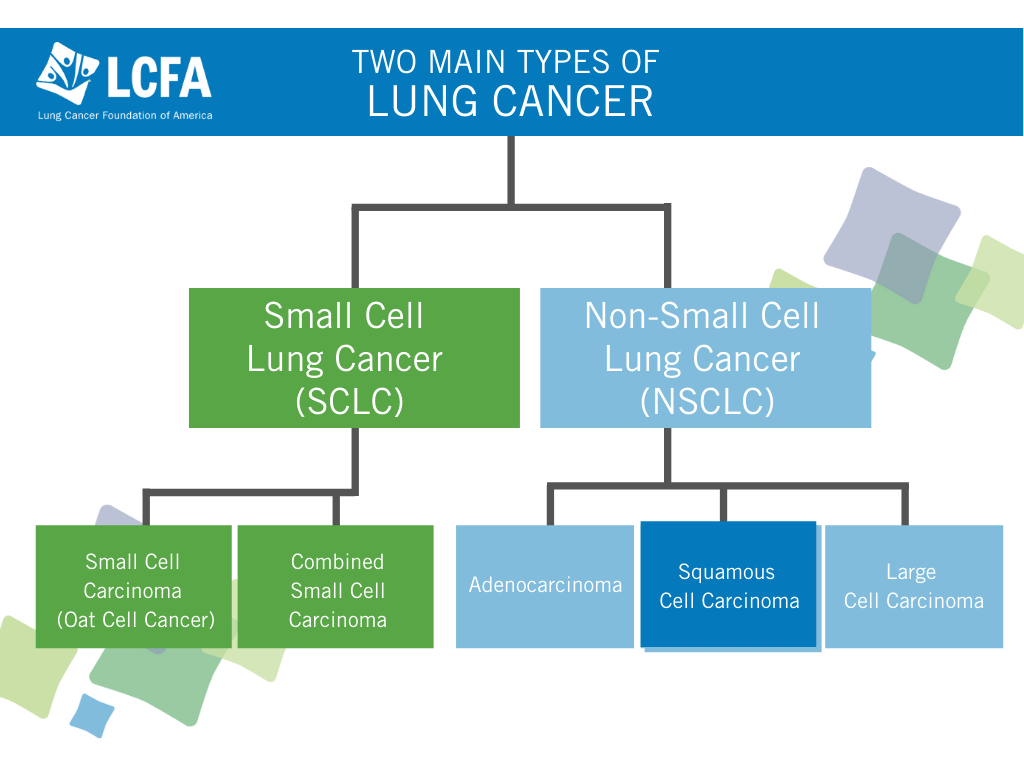About Lung Cancer | Diagnosis | Types
Squamous Cell Carcinomas
What is squamous cell carcinoma lung cancer?
Squamous cell carcinoma of the lung, also known as epidermoid carcinoma, is a cancer that originates from the squamous cells. These are thin, flat cells that line the airways, much like the lining of a pipe. They provide a barrier between the air in the lungs and the lungs themselves. Squamous cell lung cancer develops when these cells become damaged, or abnormal, and begin to multiply. The majority of cases of squamous cell carcinoma start in the center of the lung compared to other parts of the respiratory system.

Squamous cell lung cancer is a subtype of non-small cell lung cancer (NSCLC), along with adenocarcinoma and large cell carcinoma. Squamous cell carcinomas make up 25 – 30% of all lung cancers, and are the most common lung cancers found in smokers. Conversely, it is very uncommon to find squamous cell carcinomas in non-smokers.
Stages of Squamous Cell Carcinoma
- Stage 0: the cancer is found only in the top lining of the lung and has not spread outside the lung
- Stage I (IA and IB): the cancer has not spread to the lymph nodes or other parts of the body. The difference between each sub-stage is based on the size of the tumor and whether it has spread to the lung lining
- Stage II (IIA and IIB): the cancer is larger than Stage I and has begun to spread to nearby lymph nodes or tissues, but not to distant organs. The difference between each sub-stage is based on the size of the tumor, its location, and whether it has spread to the lymph nodes or not
- Stage III (IIIA, IIIB, and IIIC): the cancer may be difficult to remove via surgery. The difference between each sub-stage is based on the size of the tumor, its location, and how much it has spread
- Stage IV: the cancer has spread (metastasized) to other areas of the body outside the lungs
Symptoms
Like other types of lung cancer, many people do not experience symptoms, especially in the early stages. However, after progressing, squamous cell carcinoma can cause symptoms to present at an earlier stage than in other types of lung cancer, such as coughing up blood. Other symptoms include:
- Persistent cough
- Shortness of breath
- Hoarseness
- Bronchitis, Pneumonia, or Emphysema
- Chest pain
- Unexplained weight loss
- Bone pain
- Treatment
Causes and Risk Factors
Smoking is the main risk factor for squamous cell lung cancer, and the risk of developing squamous cell lung cancer decreases the longer a person has been smoke-free. It is rare for non-smokers to develop squamous cell carcinoma. Other factors that can put someone at higher risk for developing squamous cell lung cancer include:
- Secondhand smoke
- Exposure to asbestos
- Exposure to radon gas
- Exposure to indoor or outdoor air pollution
- Inhaling fumes, vapors, or spray paint
- Having a family history of squamous cell lung cancer, or other types of cancer
- Having a personal history of squamous cell cancer, or other types of cancer
Treatment
The treatment of squamous cell lung cancer depends on the stage of the cancer.
Surgery (lobectomy or pneumonectomy)
Surgery is the most effective treatment for squamous cell lung cancer. More than 80% of squamous cell lung cancer patients are still alive after 5 years and 80% are still alive after 10 years.
A pneumonectomy is a procedure in which the entire lung is removed. Most people can get by with one lung unless the remaining lung is impaired in some way. In the case that only part of the lung is necessary to remove, this is called a lobectomy.
Radiation Therapy or Chemotherapy
Radiation or Chemotherapy are two non-specific therapies that may be used. Radiation therapy is the practice of using high doses of radiation in order to kill cancer cells, while chemotherapy uses drugs to kill cancer cells. In both cases, because of their non-specific and non-targeted mechanisms of action, they can often harm normal, healthy cells, which can cause severe side effects like hair loss.
Radiation or Chemotherapy could be applied to shrink tumors prior to surgery, or after surgery to kill any remaining cancer cells.
Targeted Therapy
Targeted therapy is a type of treatment that detects specific features of the targeted cell, such as mutations or other characteristics, and disrupts the functioning of those specific cells – thus minimizing side effects of non-targeted, systemic treatments.
Angiogenesis inhibitors are used to treat non-small cell lung cancers, and they impede cancer cells from producing blood vessels. This prevents cancer cells from receiving nutrients and therefore, slow or stop the growth of the tumor(s).
Immunotherapy
Immunotherapy is a type of treatment that boosts the body’s natural immune response to combat cancer cells, thus circumventing side effects caused by systemic treatments like radiation and chemotherapy.
